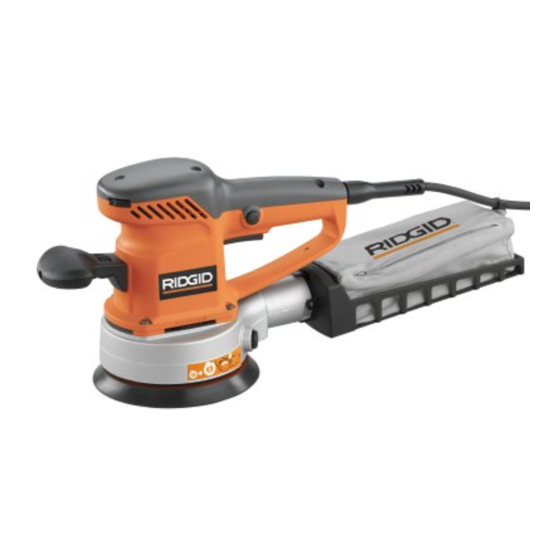Table of Contents
Advertisement
Your random orbit sander has been engineered and manufactured to our high standards for dependability, ease of opera-
tion, and operator safety. When properly cared for, it will give you years of rugged, trouble-free performance.
WARNING:
To reduce the risk of injury, the user must read and understand the operator's manual before using this product.
Thank you for buying a RIDGID product.
SAVE THIS MANUAL FOR FUTURE REFERENCE
OPERATOR'S MANUAL
RANDOM ORBIT SANDER
DOUBLE INSULATED
VARIABLE SPEED
R2610
Advertisement
Table of Contents

Summary of Contents for RIDGID R2610
-
Page 1: Variable Speed
Your random orbit sander has been engineered and manufactured to our high standards for dependability, ease of opera- tion, and operator safety. When properly cared for, it will give you years of rugged, trouble-free performance. WARNING: To reduce the risk of injury, the user must read and understand the operator’s manual before using this product. -
Page 2: Table Of Contents
TABLE OF CONTENTS Introduction...2 General Safety Rules ... 3-4 Specific Safety Rules ...4 Symbols ... 5-6 Electrical ...7 Features ... 8-9 Assembly ...10 Operation ... 10-13 Maintenance ...14 Warranty...15 Customer Service Information ...16 INTRODUCTION This tool has many features for making its use more pleasant and enjoyable. Safety, performance, and dependability have been given top priority in the design of this product making it easy to maintain and operate. -
Page 3: General Safety Rules
GENERAL SAFETY RULES WARNING: Read and understand all instructions. Failure to follow all instructions listed below, may result in electric shock, fire and/or serious personal injury. SAVE THESE INSTRUCTIONS WORK AREA n Keep your work area clean and well lit. Cluttered benches and dark areas invite accidents. -
Page 4: Specific Safety Rules
GENERAL SAFETY RULES SERVICE n Tool service must be performed only by qualified re- pair personnel. Service or maintenance performed by unqualified personnel may result in a risk of injury. SPECIFIC SAFETY RULES n Hold tool by insulated gripping surfaces when per- forming an operation where the cutting tool may contact hidden wiring or its own cord. -
Page 5: Symbols
SYMBOLS Some of the following symbols may be used on this tool. Please study them and learn their meaning. Proper interpreta- tion of these symbols will allow you to operate the tool better and safer. SYMBOL NAME Volts Amperes Hertz Watt Minutes Alternating Current... - Page 6 SYMBOLS The following signal words and meanings are intended to explain the levels of risk associated with this product. SYMBOL SIGNAL DANGER: WARNING: CAUTION: CAUTION: SERVICE Servicing requires extreme care and knowledge and should be performed only by a qualified service technician. For service we suggest you return the product to your nearest AUTHORIZED SERVICE CENTER for repair.
-
Page 7: Extension Cords
ELECTRICAL DOUBLE INSULATION Double insulation is a concept in safety in electric power tools, which eliminates the need for the usual three-wire grounded power cord. All exposed metal parts are isolated from the internal metal motor components with protect- ing insulation. Double insulated tools do not need to be grounded. -
Page 8: Product Specifications
FEATURES PRODUCT SPECIFICATIONS Sanding Disc Diameter... 6 in. (15.2 cm) Orbit Diameter ... 1/8 in. or 1/4 in. (3.2 mm or 6.4 mm) No Load Speed ... 4,000 - 10,000/min Input ... 120 Volts, 60 Hz, AC only, 3.8 Amps Net Weight... -
Page 9: Vacuum Adaptor
DUST BAG The dust bag attaches to the sander and keeps dust to a minimum. VACUUM ADAPTOR The vacuum adaptor allows you to connect to a 1-1/4 in. -
Page 10: Assembly
Do not discard the packing material until you have care- fully inspected and satisfactorily operated the tool. n If any parts are damaged or missing, please call 1-866-539-1710 for assistance. PACKING LIST Random Orbit Sander Sanding Disc, 80-grit (3) Cloth Dust Bag (1) Dust Bag Support (1) Vacuum Adaptor Hex Key Operator’s Manual... -
Page 11: Adjusting The Speed
NOTE: To determine the orbit of the sander, rotate the backing pad counterclockwise with your hand and look down on the sander from directly above the motor housing. If you can see the red backing pad top, the orbit is 1/4 in. If you cannot see the red backing pad top, the orbit is 1/8 in. -
Page 12: Cord Retainer
ATTACHING THE DUST BAG See Figure 6. The dust bag provides a dust collection system for the sander. Sanding dust is drawn up through the holes of the sanding disc and collected in the dust bag during sanding. To attach the dust bag: Unplug the sander. -
Page 13: Operating The Sander
Keep your head away from the sander and the sanding area. Your hair could be drawn into the sander causing serious injury. Place the sander on the workpiece so that all of the sanding disc surface is in contact with the workpiece. CAUTION: Be careful not to let your hand cover the air vents. -
Page 14: Maintenance
MAINTENANCE WARNING: When servicing use only identical RIDGID replacement parts. Use of any other parts may create a hazard or cause product damage. WARNING: The random orbit sander should never be connected to a power supply when you are assembling parts, making adjustments, cleaning, performing maintenance, or when the tool is not in use. -
Page 15: Warranty
2/1/04 and after. This product is manufactured by One World Technologies, Inc. The trademark is licensed from RIDGID, Inc. All warranty communications should be directed to One World Technologies, Inc., attn: RIDGID Hand Held and Stationary Power Tool Technical Service at (toll free) 1-866-539-1710. -
Page 16: Customer Service Information
R2610 Customer Service Information: For parts or service, contact your nearest RIDGID authorized service center. Be sure to provide all relevant information when you call or visit. For the location of the authorized service center nearest you, please call 1-866-539-1710 or visit us online at www.ridgid.com.

















Need help?
Do you have a question about the R2610 and is the answer not in the manual?
Questions and answers